Xynomavro is a red grape variety and - the rule rather than the exception in Greece - autochthonous. It translates as "black and sour", which does not necessarily sound inviting, especially in an era of ironed, soft wines. And apart from that? Perhaps it would be a good idea to look at the technical side, so to speak, for the time being. The main distribution of Xynomavro is in the north of Greece, in Macedonia. The main areas of cultivation with protected designation of origin are Naoussa, Amyntaio (Amynteon), Goumenissa and Rapsani.
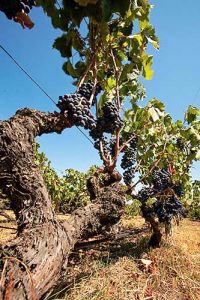 |
| Old Xynomavro vines in Naoussa% ©www-herbertlehmann.com |
As for the variety, it is not entirely uniform, at least in appearance. Sure, the shape of the leaves remains the same, but there are several variations in the grapes, from rather large-berried and elongated to stocky and small-berried. There are also certain differences in taste. The very pithy, acidic clones, which are noticeably tannic when tasted as berries, are no longer common; they have had to make way for the somewhat fruitier and gentler varieties.
The basic characteristics of the grape, namely a certain acidity and solid tannin, already indicate that this is a rather storable variety. Red berries, some plum and cherries characterise the taste of the young wine. When matured, tones of plums, tomatoes and olives appear. Unfortunately, these characteristics have become a bit of a hindrance nowadays, the whole trend tends towards wines that are ready to be consumed earlier and already flattering when young. To achieve this, Xynomavro is often blended with Merlot. The statement of a well-known oenologist from Naoussa is significant: "Xynomavro is the skeleton, Merlot is the meat". There is undoubtedly some truth in this, but it is also impressive as a single-varietal wine if it is cultivated in the vineyard and kept in check in terms of quantity, carefully vinified and, above all, then stored for a longer period of time. In the case of Xynomavro, the latest findings on micro-oxidation are also of great importance. Those who appreciate puristically vinified Nebbiolo, Sangiovese Grosso, Malbec, Tannat and the like, will certainly get their money's worth with the Xynomavro.
What could be better if you want to get an idea of a variety than to see it for yourself on the spot? Especially when you can easily fly from Germany to the centre of cultivation, Thessaloniki, in two hours. It is a real stroke of luck that since 1993 there has been an association, the "Wine Routes of Northern Greece", which takes quality very seriously. Not only with regard to the wine and the wineries, but also with regard to the restaurants and hotels. The establishments are carefully controlled and only accepted after a thorough examination. Of course, there are still a number of interesting producers and businesses that are not included, but as a guide, for basic and even quite comprehensive orientation, the Wine Routes of Northern Greece can be described as almost optimal.
Let's start our little tour of Xynomavro in Amynteon. This small area is situated relatively high, around 550 - 750 metres above sea level. Four lakes and undulating, but already quite high mountains, as well as a harsher climate, already indicate that more aromatic, quasi "northern" wines are to be expected here. Less than 30 kilometres further on, there is a popular skiing area, so the climate is already quite intense. The winegrowing area has a variety of soils, from sandy to rather loamy and somewhat gravelly. The pure sandy soils near the lake, which are considered to be the oldest sites in the region, prove to be a small treasure trove for different clones and here and there there are still almost 100-year-old vineyards, partly planted with ungrafted vines. The total area planted with Xynomavro is 635 ha. The best information about this can certainly be given by Yiannis Hatzis, a true philosopher, as complex as his wines, and a truly authochtonous connoisseur of his region.
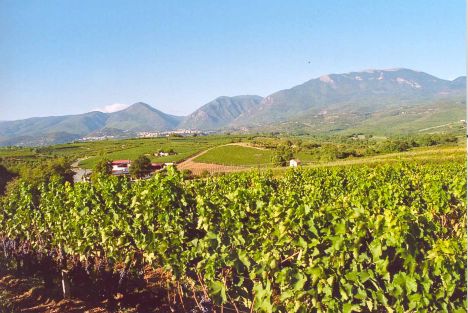 |
| Mount Vermion in Naoussa |
The winegrowers' cooperative in Amynteon, on the other hand, is still somewhat searching for its line, and is also undergoing a great deal of upheaval in terms of modernising the business. However, one can expect that in the next few years the cooperative will be able to offer quite appealing qualities, not least because it is trying to make a difference in terms of quality clones.
The relatively young, but already internationally successful company "Alpha Estate" does not struggle with these problems. From the very beginning unconditionally focused on quality, the 50-hectare winery, run by oenologists, can be seen as a leading enterprise in the region in terms of vineyard work and cellar technology (in the best sense of the word). Professional, efficient, of a high international standard, modern and yet connected to tradition in the right measure, with heart and brain, this is how one could characterise this model winery.
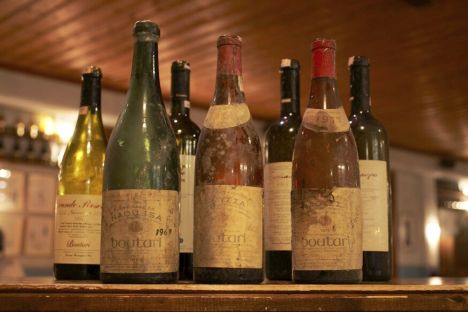 |
| Ripe Naoussa OPAP wines from the Boutari winery% ©www-herbertlehmann.com |
The most famous wine-growing region in Greece and also the first with a controlled designation of origin is Naoussa. Characterised by slopes at the foot of the Vermio mountain ridge - the planted area is about 700ha at a sea level of 80 to 400m - the area presents itself almost idyllic to the visitor. Here, Xynomavro and viticulture are closely linked to the large, internationally active Boutari winery. This company has left its mark on this region in a unique way, both in terms of viticulture and socio-economically and culturally. Without Boutari, this focus on the traditional Xynomavro variety and the fame of the wines would not exist in this form today. In the course of this development, a number of interesting wineries not dependent on Boutari developed here. The best known of the new wineries is certainly Kir-Yanni, owned by Yiannis Boutaris, an enterprising, self-confident man who has broken away from the big family business and also has a lot to say in Greek politics. The wines, which are quite international in style, are also easily available in Germany. The Dalamara winery is one of the organic wineries in Greece. Uncompromising, very skilfully vinified wines with that certain something in terms of signature and terroir show how the region could continue in the future. If you have the opportunity, you should spend more than one day in Naoussa, as the wine scene here is quite diverse. You can see that a lot has happened here in terms of quality, cellar technology and marketing. Moreover, the wines from and with Xynomavro are sometimes quite different, which is not least due to the fact that they are often blended with the most diverse varieties, mostly known from France. Companies such as Chrisohoou and Founti should by no means be ignored, they are also somewhat better known. A special case is Château Pegasus, whose wine (yes, singular) is only put on the market when it seems ripe to father and son Markovitis. These are very idiosyncratic wines that you really have to work for.
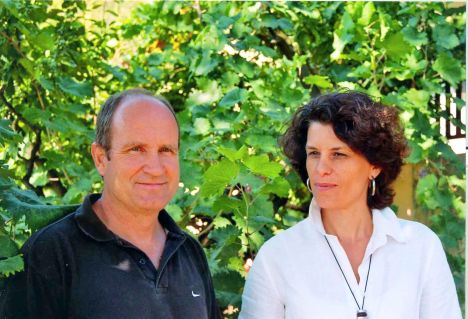 |
| Yiannis and Katerina Dalamaras |
Goumenissa is probably not that well known, perhaps because the area is quite small at 250ha. But it has its own OPAP, and rightly so. The Xynomavro here turn out quite smooth, one would almost be tempted to say quaffable. In any case, almost all have a good drinking flow and are fine food companions. This is partly due to the autochthonous variety Negoska, which serves as a blending partner for the Xynomavro. One gets a little puzzled when one compares this harmony of the two indigenous varieties with the sometimes somewhat forced partnership with imported varieties in other regions. If you are travelling from Thessaloniki, or like us, from Naoussa to Goumenissa, you should definitely stop by Ligas in Giannitsa. It's not in the OPAP area of Goumenissa, but that should only bother pure statisticians. In any case, here you get a more than good impression of what makes up the wines of the region. Arriving directly in the region, one of the interesting wineries is that of Christos Aidarinis. A modern building and a corresponding cellar actually signal the new world of wine, but here most of the wine is still sold openly. Not unappealing in a world of packaged units, but of course there are also 30,000 filled bottles per year. It is different again and also interesting when Stergios and Periklis Tatsis present their wines, which are relatively austere for the area, but mineral and rather tannic. Here, too, the large producer Boutari should not go unmentioned, because it is also true for Goumenissa that without the family's far-reaching social commitment, viticulture would not flourish here. Last but not least, the commitment of Goumenissa's only hotel, the "Dimosthenis", should not go unmentioned. Where else are 3 barrels of wine aged in the cellar, which can only be drunk in the house? The owner is an intimate and dedicated connoisseur of viticulture and distilleries in the pleasant area.
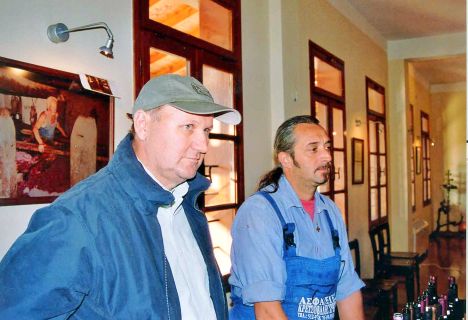 |
| The winemakers Christos Aidarinis and Stergios Tatsis |
In summary, it must be said that getting to know Xynomavro better is worthwhile from many points of view. The best way, as mentioned at the beginning, is by taking in the legendary kindness and often amazing efforts of the producers and gastronomic establishments on the spot.
Detailed maps and information material can be found on the homepage of the "Wine Routes of Northern Greece".
www.wineroads.gr
Recommended hotels we have visited
Hotel Esperides
Naoussa
Owner: Dimitrios Mantsios
www.esperideshotel.gr
Hotel Dimosthenis
Goumenissa
Owner:Fam. Mouzouris
www.dimoshotel.gr
Restaurant & Hotel Kontosoros
Owner: Nikos Kontosoros
Xyno Nero, Amynteon
Phone: +30 23860 81256
Fax: +30 23860 81552